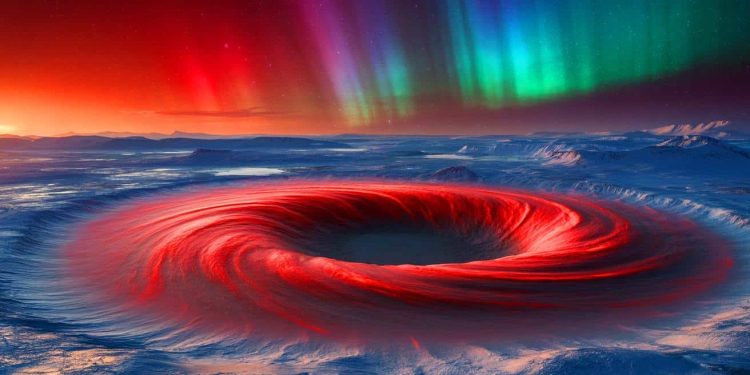| IN A WORD |
|
Mars, a planet known for its bright red surface and its past life potential, continues to surprise scientists with its atmospheric phenomena. Recent observations have revealed a rare overview of the Northern Martian polar vortex, an area where temperatures drop considerably below the surrounding environment. This extreme cold, associated with the total absence of sun, leads to an unexpected increase in ozone levels. Understanding this process is crucial for scientists, as this could shed light on the planet’s past atmospheric conditions, possibly revealing if Mars once had a layer of protective ozone similar to that of the earth.
Extreme cold in the Martian polar vortex
The northern polar vortex of Mars has a unique atmospheric phenomenon characterized by extreme cold and darkness. Scientists discovered that temperatures inside this vortex can drop up to around 40 degrees Celsius less than outside its limits. This high temperature difference is a consequence of the axial inclination of the planet, similar to that of the earth, which causes seasonal changes. During the Martian winter, the North Pole knew total darkness, creating the conditions necessary for the formation of this vortex.
Dr. Kevin Olsen of Oxford University was at the forefront of studying these conditions. According to Olsen, the absence of sun during the winter months allows ozone levels to increase considerably in the vortex. Normally, ozone is broken down by reactions involving water vapor and ultraviolet rays of the sun. However, in the absence of water vapor, this destructive process stops, causing an accumulation of ozone. This overview of Martian atmospheric chemistry offers clues to the planet’s past and on the potential existence of a protective ozone layer.
These Martian discoveries to which scientists did not expect divide the entire scientific community into two
The role of ozone in the Martian atmosphere
Ozone is an essential element for understanding atmospheric chemistry in Mars. It is a reactive form of oxygen which provides valuable information on the atmospheric conditions and the history of the planet. The presence of ozone in the polar vortex suggests that atmospheric reactions on Mars differ considerably from those on earth. This discovery offers an overview of the evolution of the Martian atmosphere over time.
If Mars once had a complete layer of ozone, it could have protected the surface from harmful ultraviolet rays, thus potentially increasing the planet’s habitability billions of years. The next mission of the Rover Exomars Rosalind Franklin of the European Space Agency, scheduled for 2028, aims to seek signs of ancient life. Understanding the historical presence and variability of ozone could improve the orientation and the results of the mission, thus offering a clearer image of the March potential in its old past.
“We have found life on Mars”: the Rover Perseverance of NASA discovers old microbial evidence in a sample of rock of the Jezero cratero
Challenges related to the study of the polar vortex
The study of the Mars polar vortex poses significant challenges due to the total darkness which envelops the North Pole in winter. Traditional observation methods, which rely on sunlight to detect atmospheric molecules, become ineffective. However, scientists have developed innovative techniques to overcome these obstacles.
The Exomars Trace Gas Orbiter, equipped with the suite of atmospheric chemistry (ACS), plays a crucial role in exploration of the Martian atmosphere. By analyzing the solar light absorbed at different wavelengths, scientists can determine the composition and distribution of atmospheric molecules. However, during the polar night, when sunlight is absent, researchers must rely on alternative data sources. The Mars Climate Instrument Stern of Mars Recognition Orbiter of NASA provides temperature measures which help to identify the extent of the vortex, allowing scientists to determine when and where the shape of the vortex changes.
“I can’t believe what I saw”: the first capsule escape test in China for 30 years ends with a dazzling success that changes everything
Future implications for the exploration of March
The study of the northern polar vortex in March and its impact on ozone levels have significant implications for the future exploration of March. Information from these observations improves our understanding of atmospheric dynamics and Martian chemical processes. They also offer clues to the climate history of the planet and its potential to welcome life in the past.
While researchers continue to unravel the mysteries of the Mars atmosphere, these discoveries could shed light on future missions and the search for life. If Mars once had conditions conducive to life, understanding its atmospheric evolution could help identify regions of interest to explore. With the Rover Exomars Rosalind Franklin ready to study ancient life, the study of the polar vortex and the dynamics of ozone becomes even more relevant. As we deepen our understanding of Mars, what other atmospheric phenomena could we find out who could reshape our vision of our neighboring planet?
This article is based on sources verified and supported by editorial technologies.
Have you enjoyed? 4.5/5 (21)









